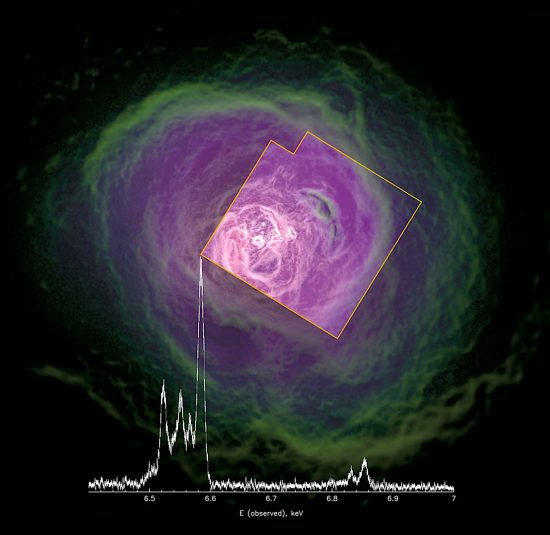
Combined Chandra X-ray Observatory/Hitomi observations of the Perseus galaxy cluster. Credit: Hitomi Collaboration/JAXA, NASA, ESA, SRON, CSA
Aug 3, 2016
So hot that the Devil took the day off!
When gas and dust collapse the material naturally warms up, radiating thermal energy. Stellar and galactic evolution is commonly thought to proceed according to mechanical action. Galaxies, stars, planets, and stardust itself are said to be the result of gravitational collapse, or compression.
Cosmological theories suggest that compression heats gas as it is drawn together by gravity. Clouds of hydrogen and dust somehow collect in a common center, forming regions of increased density that coax more material to collect there. Eventually, nuclear fusion converts hydrogen into helium, releasing a self-sustaining reaction. This is the consensus model of star birth.
Recently, scientists using the Soft X-ray Spectrometer onboard the ill-fated Hitomi space observatory saw what they believe to be the rapid movement of hot gas in the center of the Perseus cluster. Perseus is the brightest X-ray emitting galaxy cluster in the sky, containing more than 100 galaxies. Temperatures at the center of the cluster indicate that it is over 50 million Kelvin, due to a powerful jet from Galaxy NGC 1275‘s supermassive black hole.
Turbulence in the hot gas is what drives up temperatures, as the press release notes, so the research team was surprised to find that it was “unexpectedly low”. Apparently, this is another glitch in the prevailing ideas about cosmic evolution.
Thermal energy is created when atoms collide. Various wavelengths emitted from those collisions correlate to their temperature. However, most radiant energy in space is synchrotron radiation generated by electrons spiraling through magnetic fields. Electrons in motion are called electricity. Electric charge flow through a magnetic field is defined as a “field-aligned electric current”, otherwise known as a Birkeland current. Birkeland currents release synchrotron radiation, although synchrotron radiation provides no indication of temperature.
Rather than shock waves from a jet of gas, the Perseus cluster emits X-rays because electricity is passing through its dusty plasma. X-ray radiation is typical of that given off by highly excited stars, indicating extremely strong electrical stress.
No material at 50 million Kelvin is “hot gas”. No atoms remain intact at such temperatures: electrons are stripped from nuclei, creating powerful electric fields, a characteristic of matter in the plasma state. In that condition, it can conduct electricity and form double layers.
Nobel laureate Hannes Alfvén maintained that double layers are a unique celestial object, and that intense X-ray sources could be due to double layers “shorting out” or exploding. Double layers can accelerate charged particles up to enormous energies in a variety of frequencies. If the charge density gets too high they explode, drawing electricity from the entire circuit, consequently discharging more energy than was contained in the double layer.
Particle accelerators inside galaxy clusters are manifestations of Birkeland currents pouring electricity into double layers—streamers of plasma can be seen flowing through them. So the plasma Universe reveals itself.
Stephen Smith












